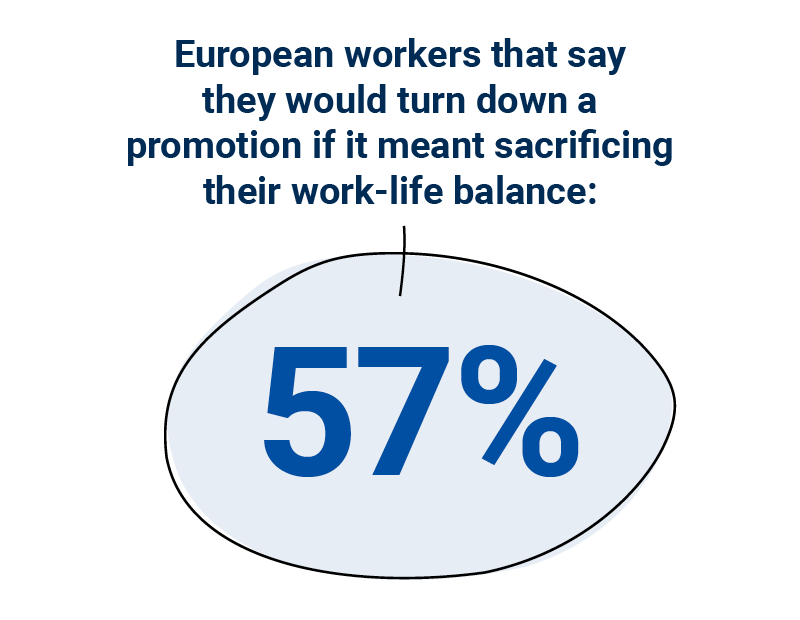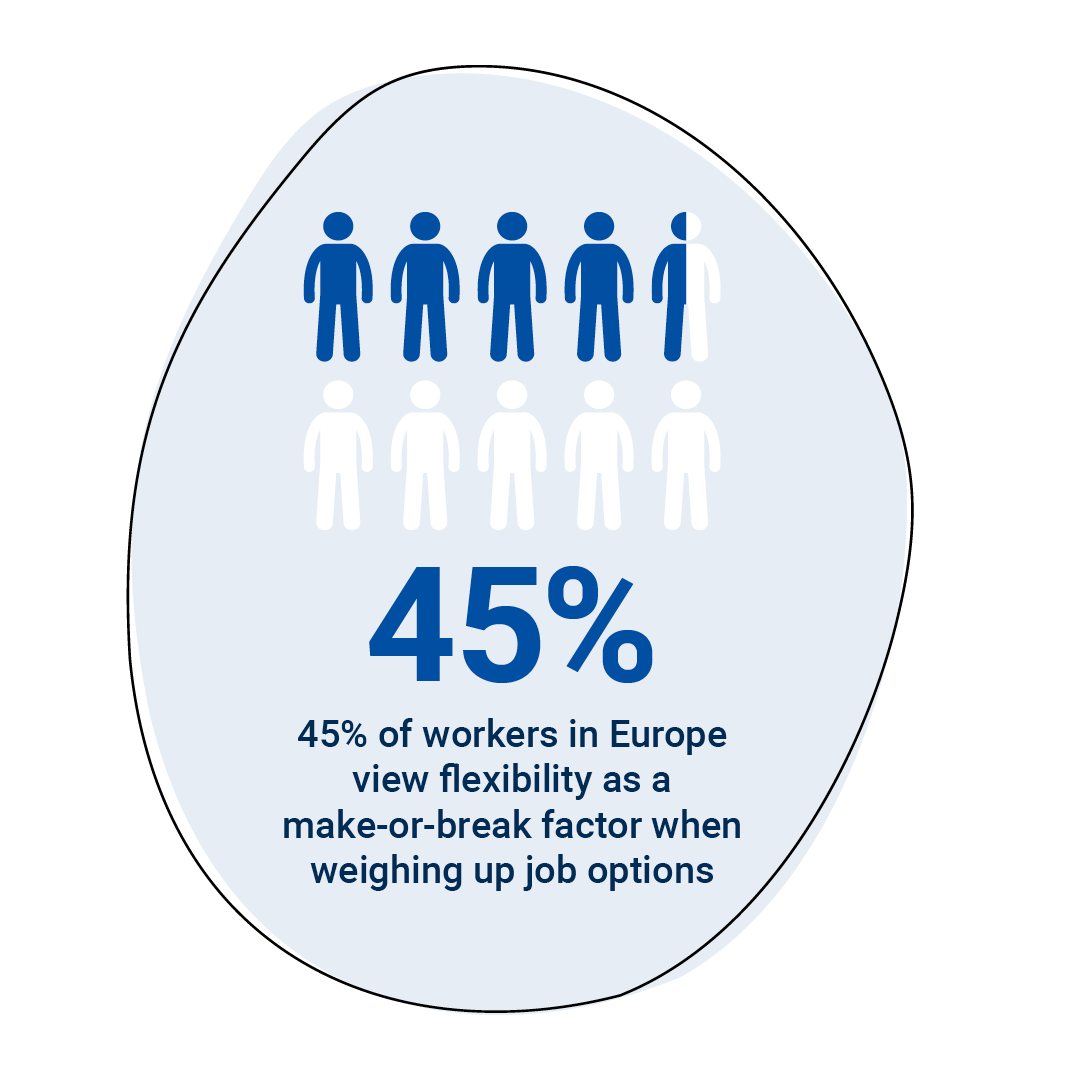

Are workers leading the charge towards a better work-life balance? It seems so. The flexible working revolution is one of the clearest trends to emerge from the pandemic, and nowhere is this truer than in Europe. It’s gone from a perk to a priority for job seekers.
This sentiment is revealed in our Talent Trends 2024 report, a comprehensive global survey of nearly 50,000 skilled professionals conducted by PageGroup. The annual study shows that the expectation for flexible working hours is greater than last year, even while companies increasingly demand employees return to the office.
The importance of flexible working in Europe
The numbers speak loud and clear. Of the 16,046 workers who completed the survey in Europe:
- Over half (57%) would skip out on a promotion for the sake of their well-being. This trend is especially strong in the Netherlands, UK and Switzerland.
- More than 2 in 5 say flexibility is a significant factor when deciding on a job, ranking it second most important overall.
- Half (51%) are already in hybrid roles, with a striking 7 in 10 Austrian and Swiss workers enjoying this setup.
The office is making a comeback, but not everyone’s happy about it. 3 in 10 employees spend more time there now than a year ago, often due to stricter company rules. Employers take note: those forced back to the office are more likely to be actively job hunting and unhappy with their current role.
The bottom line? In today’s competitive market, flexible work options are essential to finding and keeping great employees. Workers demand flexibility, and employers who don’t adapt will get left behind. Flexibility is the key for businesses hoping to succeed in the future.

Effective employer strategies to promote workplace flexibility
True flexible working means understanding that different employees have different needs. It’s about offering options, from flexible hours and job-sharing to remote and hybrid arrangements. This personalised approach boosts job satisfaction and helps you build a more diverse and inclusive workplace.
For example, a parent might appreciate flexible working to manage school pickups, while another employee might thrive with a compressed work week. Remote work options can open doors for those with caregiving responsibilities, long commutes or who simply work best outside a traditional office.
Of course, companies have their own priorities. So, how do you balance employee needs with organisational goals?
1. Empower your team with adaptable policies
Offering your employees choices lets them tailor their work schedule to suit their individual needs, ultimately leading to higher job satisfaction. Examples of flexible working arrangements you could implement include:
- Remote work: Also known as telecommuting, this allows an employee to work outside the office, either part-time or full-time. While some companies restrict remote work to the same city, others have found benefits in allowing employees to work abroad for extended periods. This can boost employee morale and retention by enabling them to travel or visit family without eating up vacation time.
- Hybrid model: A blend of in-office and remote work. The specific office days could be fixed or flexible. Giving staff more control over their in-office schedule can help them better manage personal commitments and work more efficiently.
- Flextime: The number of hours worked is fixed, but the employee has flexibility over start and finish times. This allows them to avoid rush hour commutes, attend appointments or work at the times when they’re most productive.
- Compressed workweek: Condensing full-time hours into fewer days, typically allowing staff to enjoy a three-day weekend or Friday afternoons off. This arrangement can improve work-life balance and boost productivity, as employees are motivated to work more efficiently to enjoy their extra time off.
- Job sharing: Allows two or more employees to work part-time in a shared role. This can be an attractive option for parents, caregivers or people pursuing further education, enabling them to maintain a career while managing other responsibilities.
- Part-time work: Typically under 30 hours a week. Remember that advertising only full-time roles may limit your talent pool and exclude strong candidates. Offering part-time options can help you attract and retain diverse talent, including parents, older workers or those with health conditions.

2. Get leadership buy-in
Can you convince your company’s leadership to embrace flexible working? Don’t just tell them it’s the right thing to do – show them. Share success stories from similar organisations, highlight potential cost savings and emphasise the long-term benefits for recruitment and retention.
3. Research your competition
Playing catch-up with flexible working policies puts you at a disadvantage. If your offerings lag behind competitors, you'll struggle to attract top talent and risk losing your best employees. Aim to surpass, not just match, the benefits of others in your industry.
4. Arm your employees with the right tech
Truly embracing flexible work means empowering your team to work asynchronously. Invest in collaboration tools designed for this type of work, such as:
- Project Management: Asana, Trello or Basecamp
- Visual Collaboration: Mural, Miro or Figma
- Communication: Switchboard, Twist or Slack
- File Sharing & Storage: Google Workspace, Microsoft 365 or Dropbox
5. Offer a remote work allowance
This can cover the costs of setting up a home office (e.g. ergonomic chairs, desks and computer upgrades). You could also allocate an amount towards a portion of the employee’s monthly utility, phone and internet bills to offset the increased usage associated with remote work.
6. Highlight the value of time spent in the office
In the case of hybrid models, a smart flexible working policy should promote the merits of working both in and out of the office. Our Talent Trends 2024 survey found that younger employees value the career development opportunities of being physically present in the office. A quarter of respondents in their 20s noted they work in the office more than they did a year ago to learn from colleagues, so introducing on-site opportunities like mentorships or secondments, for example, can be a significant draw.
7. Review employees based on results, not hours
One of the biggest challenges with rolling out flexible working is monitoring performance. Rather than worrying a remote worker might not be logging their full 35 or 40 hours, managers should focus on work quality, project goals and timely results. Setting measurable objectives and scheduling regular virtual catch–ups is essential. Employees ultimately feel more trusted and empowered, contributing to a greater sense of autonomy and a positive workplace culture.
8. Offer support to remote workers
At times, employees working remotely may feel isolated or stressed. Virtual check-ins are also an opportunity to manage a person’s workload and ensure they don’t become overwhelmed. Additionally, an Employee Assistance Programme (EAP) can give staff free access to confidential, professional support for personal problems affecting their work performance, such as mental health issues or financial concerns.
9. Run a pilot flexible working project
If you’re uncertain whether flexible working will succeed within your organisation, begin with a trial run. Begin by surveying your employees on what flexible working means to them and what options they would like to see. Then, start small by testing your proposed policies on one or two teams, making sure to include all elements that will eventually be rolled out to the entire workforce. This might include piloting hot desking, where employees choose a workspace on a first-come, first-served basis, or hoteling, where specialist software allows staff to book specific spaces in advance.

Conclusion: Flexible working boosts employee well-being and your company’s bottom line
Flexible working isn’t just a trend – it’s the key to building a happier, more productive and loyal workforce. It’s an approach that leads to fresh ideas and innovative solutions, ultimately making your business more successful. In today's competitive market, companies that prioritise flexibility will stand out, attracting and keeping the best talent. The future of work is flexible – is your business ready?
If you are hiring and want to find out how Michael Page can help you with your recruitment needs, contact us today.
Frequently asked questions
What is flexible work?
Flexible working encompasses a variety of arrangements which give employees greater control over their work schedules and locations. This can include options such as remote work, compressed hours, part-time schedules and job sharing. It can help lead to a healthier work-life balance and improved well-being.
Employers profit from increased employee satisfaction, greater productivity, lower absenteeism and higher retention rates. Overheads are reduced, too – a business may need less physical space if a portion of the staff is working remotely each day, while decreased staff turnover cuts the cost of hiring and training. Remote working also opens up access to a highly skilled, global talent pool.
How to ask for a flexible work schedule
There are several steps you can take when approaching your manager:
- Point out the benefits to you and the organisation. For example, mention you will be more productive working from home where you have fewer interruptions.
- Be clear about what you want. Go into your meeting with a specific proposal for your personalised flexible working arrangement.
- Listen and be open to negotiation. Be prepared to address any concerns, emphasising your commitment to deadlines and communication, and be willing to meet in the middle.
Join over 80,000 readers!
Receive free advice to help give you a competitive edge in your career.